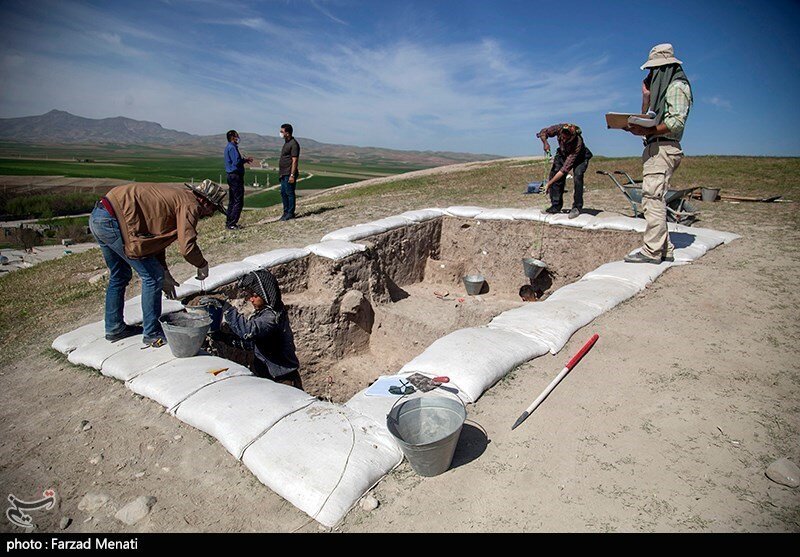Archaeologists shed new light on Paleolithic site in western Iran

TEHRAN – A team of archaeologists has conducted a survey to document a vast prehistoric site in western Iran.
The site, named Sang-e Madan, is situated in Kermanshah province and it dates from the Lower Paleolithic and Middle Paleolithic periods, with an estimated age ranging from one million to 40,000 years ago.
According to Nemat Hariri, head of the archaeological investigation team, the new discoveries in the site have the potential to reshape the existing understanding of human history and prehistoric life in the Iranian Plateau.
Hariri referred to the findings of a 2021 survey led by Dr. Saman Heydari-Guran, a distinguished Paleolithic archaeologist, said: “That survey underscored the site’s importance as a key archaeological zone in southern Kermanshah.”
The archaeologist added that the site spans approximately 320 hectares and has yielded numerous artifacts, including stone tools, which provide crucial insights into the activities and lifestyles of prehistoric communities.
As mentioned by Hariri, Sang-e Madan represents one of Iran’s most extensive Paleolithic archaeological zones. The site has revealed a treasure trove of stone tools and cultural artifacts spanning from the early Lower Paleolithic to the Middle Paleolithic period. These findings indicate that the site was continuously occupied by diverse communities for nearly a million years, offering a window into the cultural evolution of early human societies.
“The artifacts discovered at Sang-e Madan show a remarkable continuity of human occupation,” said Hariri.
One of the most notable aspects of the Sang-e Madan site is its association with the Acheulean culture, known for its distinctive stone hand axes. The discovery of these tools suggests that early human populations utilized the rich natural resources of the region to create tools essential for their survival. The abundance of raw stone materials in the area likely played a crucial role in attracting prehistoric communities, who relied on these resources to manufacture various implements for hunting, food processing, and other daily activities.

“We have uncovered stone tools that date from about one million years ago to 40,000 years ago, including items associated with the Acheulean culture. This suggests that the area was a significant center of human activity during prehistoric times.”
He said in the 1960s, when a team from the University of Chicago, led by Robert Braidwood, discovered a stone axe in the nearby Gakiyeh village. “This initial discovery laid the groundwork for further exploration and understanding of the region’s prehistoric significance. Today, the recent findings at Sang-e Madan have surpassed expectations, uncovering not just a single tool but a vast array of artifacts that offer new insights into Iran’s prehistoric past.”
Despite its importance, the Sang-e Madan site faces significant threats from modern development and neglect.
Hariri expressed concerns about urban expansion, road construction, and agricultural activities that endanger the preservation of this invaluable archaeological site.
A call for collaborative conservation efforts
To safeguard the Sang-e Madan site, Hariri and his team are actively working on a proposal to establish protective measures and legal boundaries. They seek collaboration with relevant bodies to ensure the site’s preservation and protection.
“In our efforts to protect this national treasure, we are compiling a comprehensive proposal for establishing protective measures and boundaries,” Hariri stated. “This initiative requires collaboration with the Kermanshah’s Cultural Heritage Department, local authorities, and even law enforcement forces to ensure the site is preserved for future generations.”
Million years of continuous human settlement
According to Heydari-Guran, Kermanshah is a unique region that has enjoyed continuous human settlement for one million years.
“We have abundant evidence indicating one million years of human settlement in Kermanshah, which is an exception in the plateau of Iran and even in West Asia…,” the top archaeologist has said.
“In addition, the geography of this region is full of ancient monuments that have been affected by many factors,”
Heydari-Guran made the remarks in July 2022 at an event organized to mark the 16th anniversary of Bisotun’s registration on the UNESCO World Heritage list.
According to Heydari-Guran, the creators of those tools may have been the so-called ‘Homo erectus’, although other groups [of early humans] made similar tools, given the similar sites in other parts of Asia.
“During a week-long survey in this area, tens of stone axes, utensils, and mother stones related to the [Lower] Paleolithic period were discovered, which according to their technical characteristics and typology are related to the Acheulean era,” the archaeologist said.
“This is the first time in 60 years that tools from the Paleolithic period have been discovered in Kermanshah,” the archaeologist said.
AM
Leave a Comment